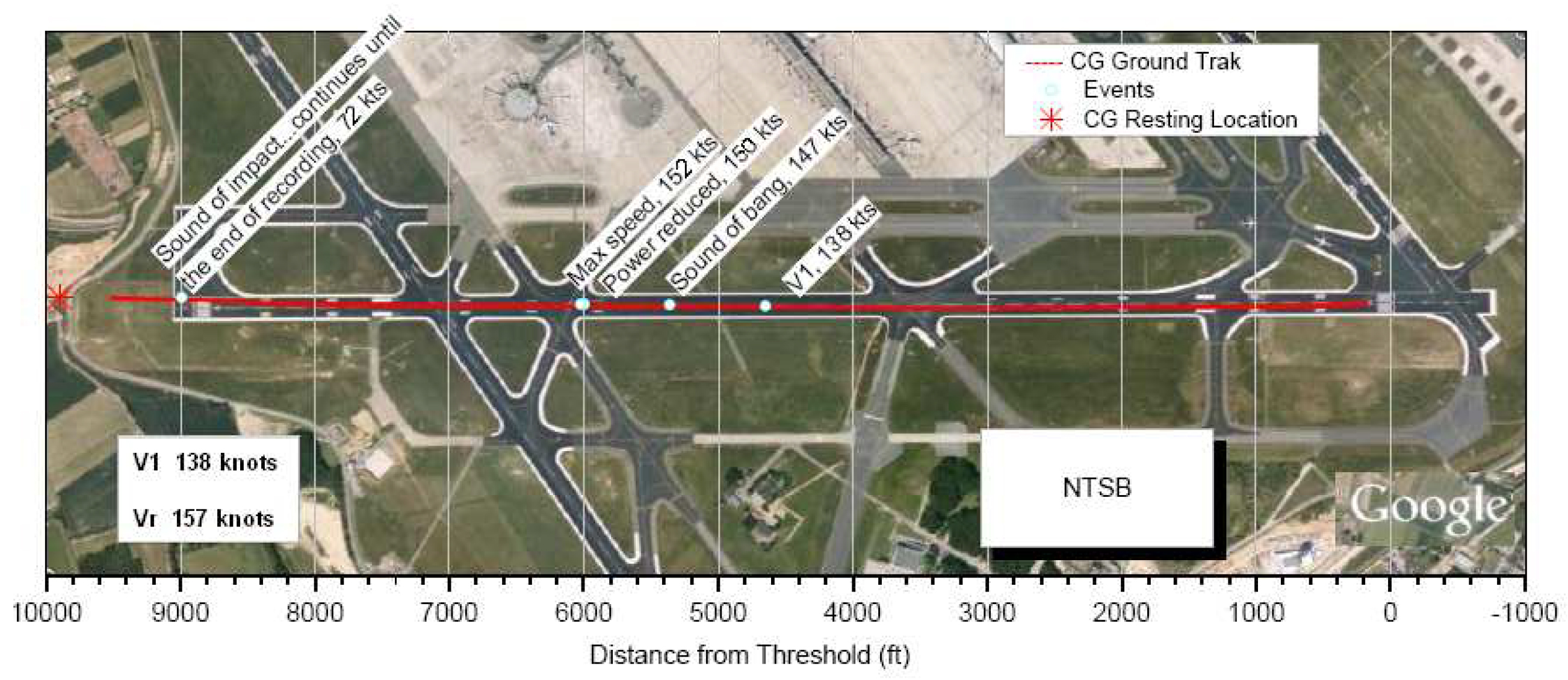What is the sound of a 6 ounce bird flying into a 50,000 lb thrust engine? It can make a huge sound, some say it is on the order of hearing a shot gun blast. I've had the engines on my Boeing 747 ingest a bird or two and it wasn't that bad. I've also eaten a few birds in the Boeing 707 and it was. The point is, it makes a loud, sudden noise.
— James Albright

Updated:
2019-03-31
But does that mean the engine is going to quit? Probably not. But if you are surprised by the noise, it can cause you to abort the takeoff even though all of the engines are running fine.
This is the case of the captain making a bad decision a few seconds after V1 and then doing a poor job of executing the takeoff abort. I wasn't going to cover it because I thought the lessons obvious. But I wanted an example of how vesting 100% of the abort authority in the captain can make the captain weigh abort decisions with less diligence than if he or she knew that decision was being made in parallel from the other seats in the cockpit. More about that: Abort Authority.

1
Accident report
- Date: 25 May 2008
- Time: 13:31
- Type: Boeing 747-209F
- Operator: Kalitta Air
- Registration: N704CK
- Fatalities: 0 of 4 crew, 0 of 1 passengers
- Aircraft fate: Damaged beyond repair
- Phase: Takeoff
- Airport (departure): Brussel-Zaventem Airport (EBBR), Belgium
- Airport (arrival): Bahrain International Airport (OBBI), Bahrain
2
Narrative
The captain failed to line up at the end of the runway, aborted the takeoff 5 seconds after V1, did not use the thrust reversers, did not extend the speed brakes, and did not apply maximum braking. These are the facts. Now why did he initiate the abort?

Distance from threshold, Kalitta 207, AAIU-2008-13, p. 37
- The airplane taxied towards the B1 intersection for the Runway 20.
Source: AAIU-2008-13, ¶1.1
The steering system on the 747 makes it capable of making very tight ground turns, the crew could have gained a few hundred feet by taxiing to the end of the runway.
- The airplane was cleared for take-off at 11:29.
- The pilot pushed the throttles forward and checked the engines were stable.
- The Flight Engineers then set the engine power for take-off (setting “normal”, also known as “reduced thrust”).
- The aircraft started to accelerate. The standard call-out were made when the speed reached the determined value. - “airspeed” - 80 knots - V1
- A few seconds after reaching V1, the engine N°3 ingested a bird.
- Approximately 5 seconds after V1, the engine N°3 stalled and caused a loud “bang”, and a vibration felt in the cockpit.
- The pilot stated he had the feeling that the aircraft was no longer accelerating, and decided to abort the take-off. Two seconds after having heard the detonation, the thrust levers were brought back to idle, and braking action was initiated. The thrust reversers were not deployed.
- The FO called the tower, and notified the aircraft was going to the overrun.
- The pilot turned the aircraft a few degrees to the right, in order to avoid the approach lights at the end of the runway.
- The aircraft left the runway at a speed of approximately 72 Knots.
- The aircraft reached a first embankment, dropping from a height of 4 m, and broke in three parts. The aircraft came to a stop just above the top of the railroad embankment.
- The crew exited the airplane through the service door since the L1 door normally used was blocked due to deformation of the structure.
Source: AAIU-2008-13, ¶1.1
- The FDR data show the airplane taxing onto runway 20 at time 54235 seconds. Seven seconds later the engine pressure ratio begins increasing to takeoff thrust.
- At time 54286.5 seconds the aircraft reaches V1 (V1 = 138 knots).
- Four seconds later the right inboard engine shows a 0.1 EPR reduction. Within one second of the EPR reduction, longitudinal acceleration decreases and at time 54292.5 seconds EPR decreases for the remaining three engines. The decrease in longitudinal acceleration is the first indication of a Refused Take Off (RTO) in the data and occurs at an airspeed of 150 knots (V1 + 12 knots).
Source: AAIU-2008-13, ¶1.11
It appears the decision to abort and the execution of the abort took place 2.0 seconds after the impacted engine decreased in EPR. Note that a decrease in acceleration does not mean the airplane wasn't accelerating, it means that it wasn't as accelerating as quickly as it was.
- At time 54294 seconds deceleration levels off at -0.28 g’s for just over one second before increasing to the maximum deceleration recorded during the RTO of -0.38 g’s
Source: AAIU-2008-13, ¶1.11
I'm not sure how many g's are experienced for an aggressive abort but our FOQA is tripped now and then when one of our pilots uses more than 0.5 g's on a normal stop, so I suspect 0.38 g's isn't much.
3
Analysis
If you've never flown the Boeing 747, this might surprise you: the cockpit is extraordinarily quiet. If you hear a loud "bang" it will surprise you. A small bird, hardly 6 ounces (about what you would find in a chicken sandwich), flew into the number three engine, causing it to momentarily stall all of 0.1 EPR, but it immediately recovered. The captain initiated the abort 12 knots above V1. Had he continued the takeoff, he would have had full thrust on all four engines. Had he executed the abort completely, he could have stopped on the remaining runway. But he didn't.

Number 3 Engine, black light inspection, Kalitta 207, AAIU-2008-13, p. 41
- The fan blades were inspected using a black light with the blades still installed in the fan disk. A heavy and concentrated organic smear and splatter in the axial direction on the concave side of the fan airfoils was observed at the platform between blades Nos. 31 & 32 and 32 & 33 (convex side) (242° from index mark). Blades No. 42 and 43 (329° from index mark) exhibited a light and more spread out organic smear and splatter on the airfoil concave with the smear flowing towards the blade tips. The blade numbering used are the blade numbers used during the initial installation and they sequentially increase clockwise forward looking aft.
- Organic speckled material with no directional orientation was noted on the fan exit fairing around the 6:00 o’clock position. A black light inspection of the stage 1.5 low pressure blades revealed a an organic smear of 6 consecutive blades on the concave side (pressure).
- All the stages exhibited some debris deposits but no stage exhibited soft body deformation.
- Samples were taken of the organic residues, and they were sent to the Smithsonian Institute for investigation. The Smithsonian Institute Museum of Natural History – Bird Division performed an inspection on the remains, as well as DNA analysis. The results were consistent with the characteristics of the European Kestrel (Falco Tinnunculus).
- Common Kestrels measure 34 – 38 cm from head to tail, with a wingspan of 70 – 80 cm. The average adult male weighs around 155 g with the adult female weighing around 184 g.
Source: AAIU-2008-13, ¶ 1.16
Kalitta Air is operating in accordance with a General Operations Manual, accepted by the FAA. This manual sets forth the policies and procedures by which Kalitta Air complies with the Operations Specifications issued by the FAA and the current Federal Regulations. With respect to the rejection of the takeoff, the GOM states:
- The Captain will always make the decision to reject a takeoff.
- It is important that all crewmembers communicate effectively during the takeoff. If anything abnormal is observed, call it out loudly and clearly. Make sure the words you use transmit the proper message; “Loss of Essential Power” (clearly an electrical problem) vs “Loss of Power”.
- First Officers and Flight Engineers should not use the words “reject” or “abort” unless they are confirming their understanding of what the captain has commanded.
- It may be safer to reject a takeoff when approaching V1 only if there is doubt of the aircraft’s ability to maintain flight. The problem may be more safely handled as an in-flight problem than as a rejected takeoff.
- At or after V1, unless a malfunction occurs that renders the aircraft uncontrollable, do not reject the takeoff. Statistics indicate that rejected takeoffs at V1 are very seldom successful.
Source: AAIU-2008-13, ¶1.17
- In a jet engine, air compression is achieved aerodynamically by an axial flow compressor, as the air passes through the stages of the compressor. If the air flow is disrupted, the compressor can no longer deliver compressed air to the combustion chamber. In many cases, the high-pressure condition existing behind the stalled area may create a flow reversal towards the compressor air inlet, causing an immediate thrust loss.
- Flight crews who have experienced an engine stall at takeoff report that the bang is louder than any other noise they had previously heard in the cockpit. It is often compared to a shotgun being fired a few meters away.
- In the case of N704CK, both the FDR and the inspection performed on engine showed that the stall was caused by the ingestion of a bird into the core engine (compressor). The noise analysis showed further that the engine appeared to be recovering immediately after the engine stall. There was no damage found during the engine examination that would indicate otherwise.
Source: AAIU-2008-13, ¶2.3
- The crew did not operate the thrust reversers during the stop roll, as confirmed on the FDR, resulting in a constant deceleration during the reject phase.
- The pilot stated he applied maximum braking power during the stop run.
Source: AAIU-2008-13, ¶2.6
The report treads lightly here, noting that maximum braking would have likely caused the tires to deflate, and yet 14 out of the 16 main landing gear tires were found intact. That combined with the low g-forces on deceleration tells me that the braking was not of a maximum effort.
- The speed brake lever was found in the retract position in the cockpit, while the speed brakes themselves seemed in a stowed / retract position.
Source: AAIU-2008-13, ¶2.6
4
Cause
The accident report is fairly non-committal about the actions of the captain, but the list of causes speak volumes.
- The accident was caused by the decision to Reject the Take-Off 12 knots after passing V1 speed.
- The following factors contributed to the accident;
- Engine Nr 3 experienced a bird strike, causing it to stall. This phenomenon was accompanied by a loud bang, noticed by the crew.
- The aircraft line up at the B1 intersection although the take-off parameters were computed with the full length of the runway.
- The situational awareness of the crew,
- Less than maximum use of deceleration devices.
Source: AAIU-2008-13, ¶3.2
References
(Source material)
Final Report on the Accident Occurred on 25 May 2008 at Brussels Airport on a Boeing B747-209F Registered N704CK, Federal Public Service Mobility and Transport, Ref. AAIU-2008-13, 10 July 2009, Air Accident Investigation Unit, Brussels, Belgium
